Business Models and Sustainable Development
VerifiedAdded on 2020/03/01
|8
|2062
|44
Essay
AI Summary
This essay discusses the concept of business models, their definitions, and their significance in sustainable development. It highlights various e-business archetypes and their applications, particularly focusing on Amazon's recent changes in its value chain. The essay concludes that different businesses require tailored business models to thrive.
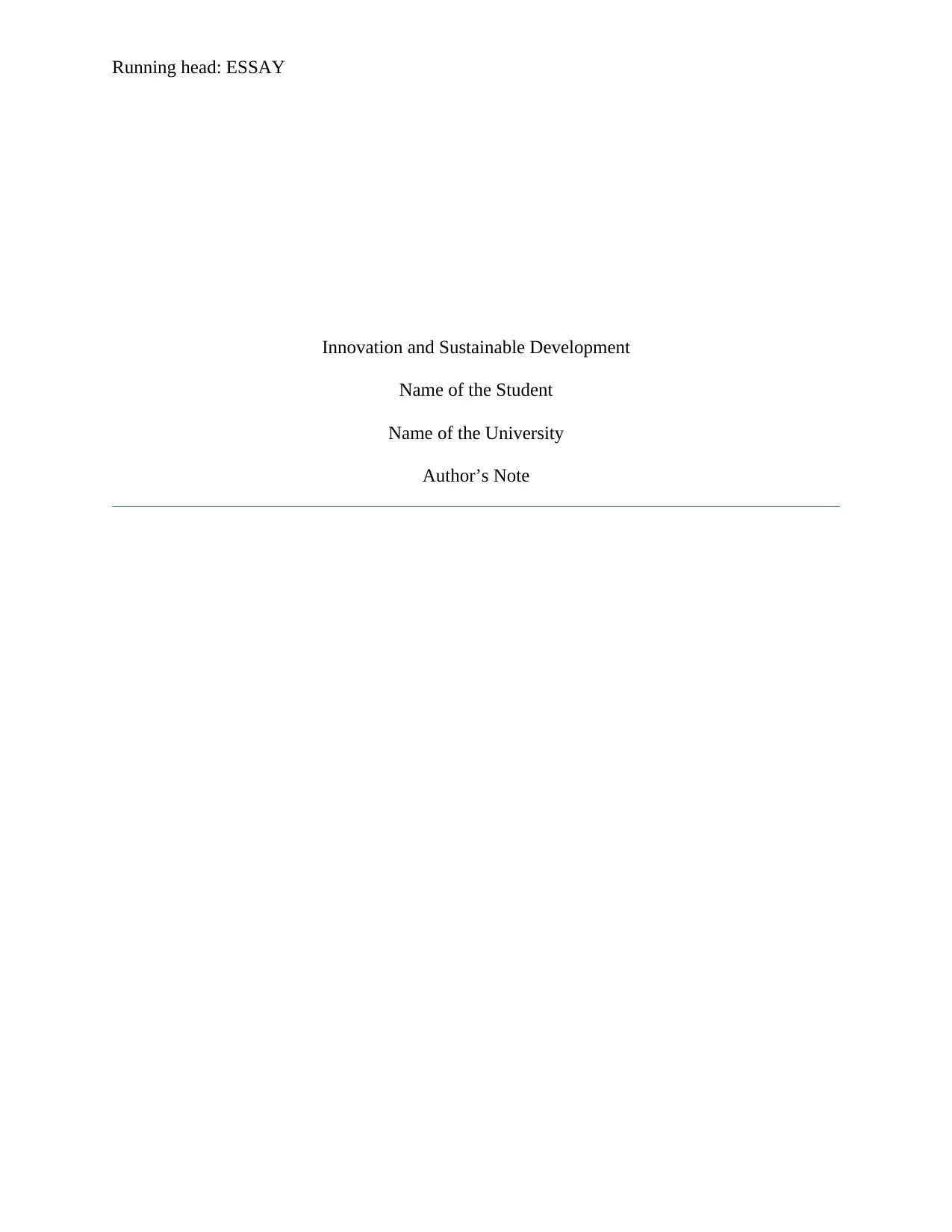
Running head: ESSAY
Innovation and Sustainable Development
Name of the Student
Name of the University
Author’s Note
Innovation and Sustainable Development
Name of the Student
Name of the University
Author’s Note
Paraphrase This Document
Need a fresh take? Get an instant paraphrase of this document with our AI Paraphraser
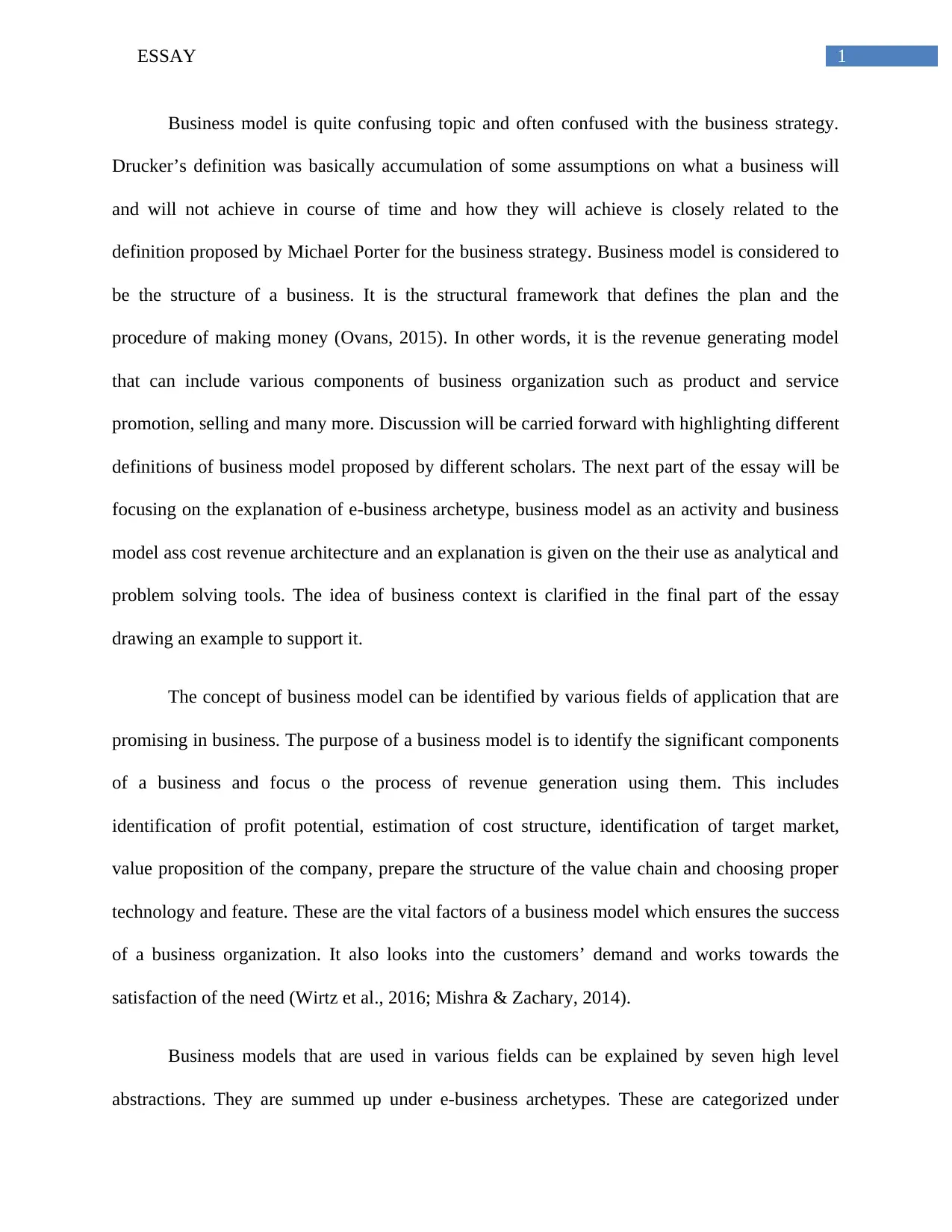
1ESSAY
Business model is quite confusing topic and often confused with the business strategy.
Drucker’s definition was basically accumulation of some assumptions on what a business will
and will not achieve in course of time and how they will achieve is closely related to the
definition proposed by Michael Porter for the business strategy. Business model is considered to
be the structure of a business. It is the structural framework that defines the plan and the
procedure of making money (Ovans, 2015). In other words, it is the revenue generating model
that can include various components of business organization such as product and service
promotion, selling and many more. Discussion will be carried forward with highlighting different
definitions of business model proposed by different scholars. The next part of the essay will be
focusing on the explanation of e-business archetype, business model as an activity and business
model ass cost revenue architecture and an explanation is given on the their use as analytical and
problem solving tools. The idea of business context is clarified in the final part of the essay
drawing an example to support it.
The concept of business model can be identified by various fields of application that are
promising in business. The purpose of a business model is to identify the significant components
of a business and focus o the process of revenue generation using them. This includes
identification of profit potential, estimation of cost structure, identification of target market,
value proposition of the company, prepare the structure of the value chain and choosing proper
technology and feature. These are the vital factors of a business model which ensures the success
of a business organization. It also looks into the customers’ demand and works towards the
satisfaction of the need (Wirtz et al., 2016; Mishra & Zachary, 2014).
Business models that are used in various fields can be explained by seven high level
abstractions. They are summed up under e-business archetypes. These are categorized under
Business model is quite confusing topic and often confused with the business strategy.
Drucker’s definition was basically accumulation of some assumptions on what a business will
and will not achieve in course of time and how they will achieve is closely related to the
definition proposed by Michael Porter for the business strategy. Business model is considered to
be the structure of a business. It is the structural framework that defines the plan and the
procedure of making money (Ovans, 2015). In other words, it is the revenue generating model
that can include various components of business organization such as product and service
promotion, selling and many more. Discussion will be carried forward with highlighting different
definitions of business model proposed by different scholars. The next part of the essay will be
focusing on the explanation of e-business archetype, business model as an activity and business
model ass cost revenue architecture and an explanation is given on the their use as analytical and
problem solving tools. The idea of business context is clarified in the final part of the essay
drawing an example to support it.
The concept of business model can be identified by various fields of application that are
promising in business. The purpose of a business model is to identify the significant components
of a business and focus o the process of revenue generation using them. This includes
identification of profit potential, estimation of cost structure, identification of target market,
value proposition of the company, prepare the structure of the value chain and choosing proper
technology and feature. These are the vital factors of a business model which ensures the success
of a business organization. It also looks into the customers’ demand and works towards the
satisfaction of the need (Wirtz et al., 2016; Mishra & Zachary, 2014).
Business models that are used in various fields can be explained by seven high level
abstractions. They are summed up under e-business archetypes. These are categorized under
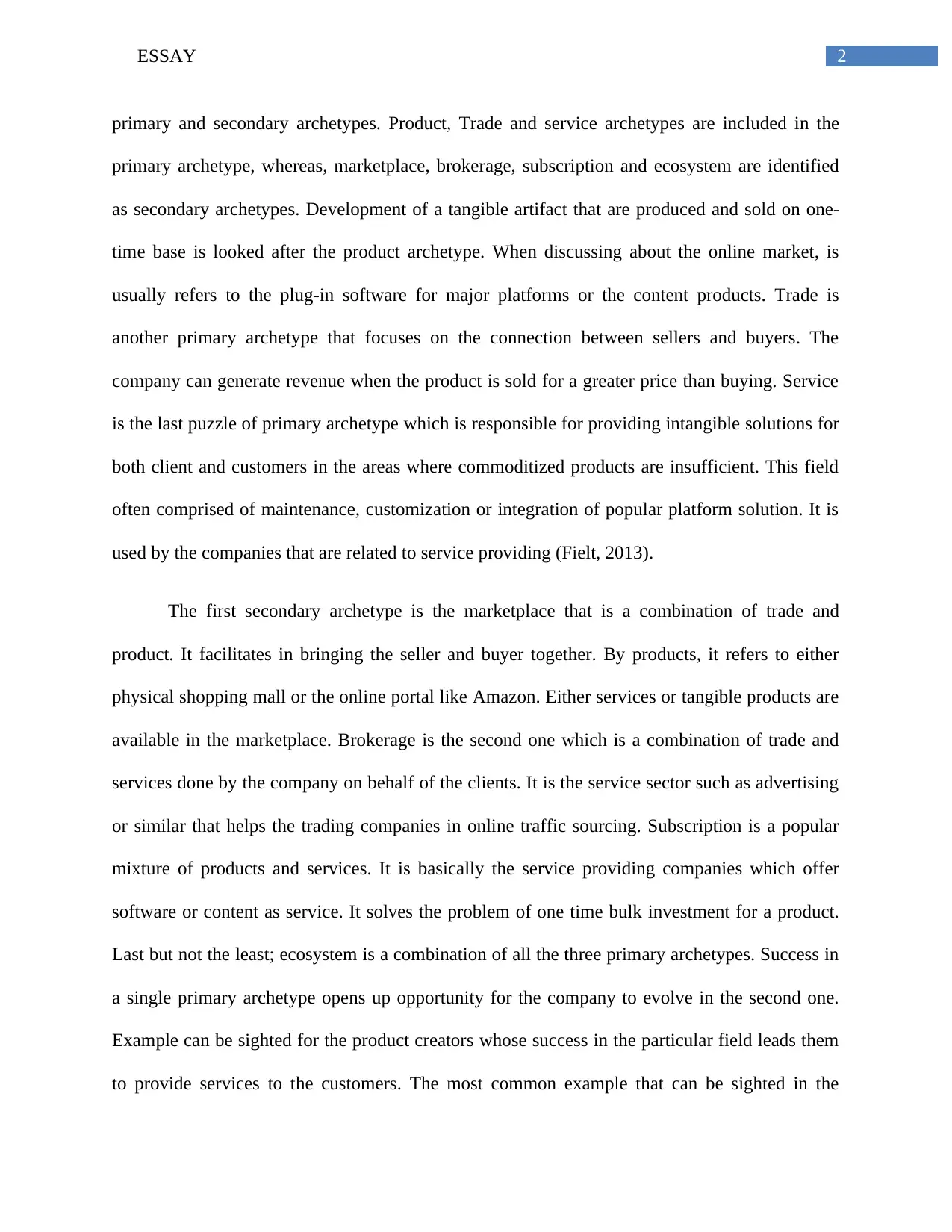
2ESSAY
primary and secondary archetypes. Product, Trade and service archetypes are included in the
primary archetype, whereas, marketplace, brokerage, subscription and ecosystem are identified
as secondary archetypes. Development of a tangible artifact that are produced and sold on one-
time base is looked after the product archetype. When discussing about the online market, is
usually refers to the plug-in software for major platforms or the content products. Trade is
another primary archetype that focuses on the connection between sellers and buyers. The
company can generate revenue when the product is sold for a greater price than buying. Service
is the last puzzle of primary archetype which is responsible for providing intangible solutions for
both client and customers in the areas where commoditized products are insufficient. This field
often comprised of maintenance, customization or integration of popular platform solution. It is
used by the companies that are related to service providing (Fielt, 2013).
The first secondary archetype is the marketplace that is a combination of trade and
product. It facilitates in bringing the seller and buyer together. By products, it refers to either
physical shopping mall or the online portal like Amazon. Either services or tangible products are
available in the marketplace. Brokerage is the second one which is a combination of trade and
services done by the company on behalf of the clients. It is the service sector such as advertising
or similar that helps the trading companies in online traffic sourcing. Subscription is a popular
mixture of products and services. It is basically the service providing companies which offer
software or content as service. It solves the problem of one time bulk investment for a product.
Last but not the least; ecosystem is a combination of all the three primary archetypes. Success in
a single primary archetype opens up opportunity for the company to evolve in the second one.
Example can be sighted for the product creators whose success in the particular field leads them
to provide services to the customers. The most common example that can be sighted in the
primary and secondary archetypes. Product, Trade and service archetypes are included in the
primary archetype, whereas, marketplace, brokerage, subscription and ecosystem are identified
as secondary archetypes. Development of a tangible artifact that are produced and sold on one-
time base is looked after the product archetype. When discussing about the online market, is
usually refers to the plug-in software for major platforms or the content products. Trade is
another primary archetype that focuses on the connection between sellers and buyers. The
company can generate revenue when the product is sold for a greater price than buying. Service
is the last puzzle of primary archetype which is responsible for providing intangible solutions for
both client and customers in the areas where commoditized products are insufficient. This field
often comprised of maintenance, customization or integration of popular platform solution. It is
used by the companies that are related to service providing (Fielt, 2013).
The first secondary archetype is the marketplace that is a combination of trade and
product. It facilitates in bringing the seller and buyer together. By products, it refers to either
physical shopping mall or the online portal like Amazon. Either services or tangible products are
available in the marketplace. Brokerage is the second one which is a combination of trade and
services done by the company on behalf of the clients. It is the service sector such as advertising
or similar that helps the trading companies in online traffic sourcing. Subscription is a popular
mixture of products and services. It is basically the service providing companies which offer
software or content as service. It solves the problem of one time bulk investment for a product.
Last but not the least; ecosystem is a combination of all the three primary archetypes. Success in
a single primary archetype opens up opportunity for the company to evolve in the second one.
Example can be sighted for the product creators whose success in the particular field leads them
to provide services to the customers. The most common example that can be sighted in the
⊘ This is a preview!⊘
Do you want full access?
Subscribe today to unlock all pages.

Trusted by 1+ million students worldwide
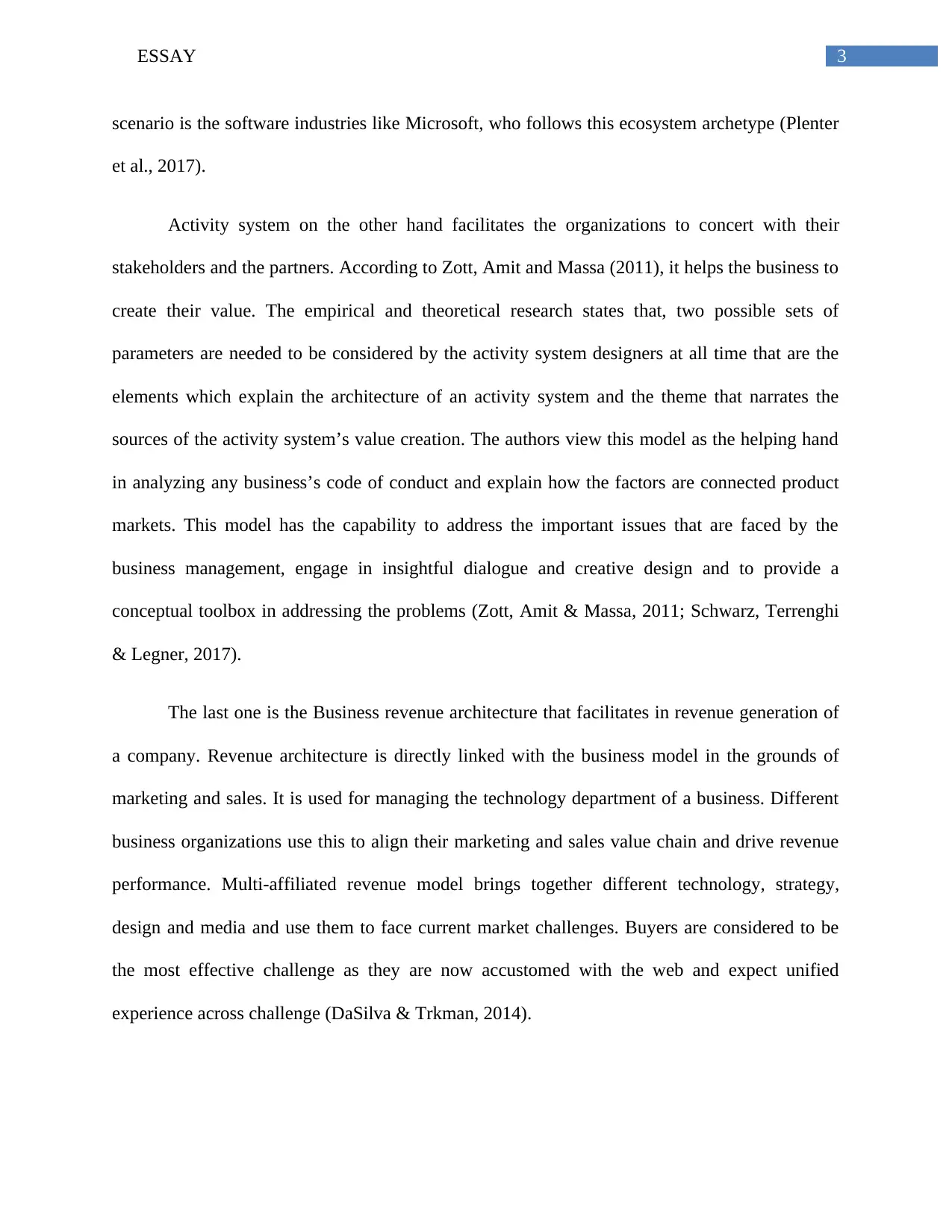
3ESSAY
scenario is the software industries like Microsoft, who follows this ecosystem archetype (Plenter
et al., 2017).
Activity system on the other hand facilitates the organizations to concert with their
stakeholders and the partners. According to Zott, Amit and Massa (2011), it helps the business to
create their value. The empirical and theoretical research states that, two possible sets of
parameters are needed to be considered by the activity system designers at all time that are the
elements which explain the architecture of an activity system and the theme that narrates the
sources of the activity system’s value creation. The authors view this model as the helping hand
in analyzing any business’s code of conduct and explain how the factors are connected product
markets. This model has the capability to address the important issues that are faced by the
business management, engage in insightful dialogue and creative design and to provide a
conceptual toolbox in addressing the problems (Zott, Amit & Massa, 2011; Schwarz, Terrenghi
& Legner, 2017).
The last one is the Business revenue architecture that facilitates in revenue generation of
a company. Revenue architecture is directly linked with the business model in the grounds of
marketing and sales. It is used for managing the technology department of a business. Different
business organizations use this to align their marketing and sales value chain and drive revenue
performance. Multi-affiliated revenue model brings together different technology, strategy,
design and media and use them to face current market challenges. Buyers are considered to be
the most effective challenge as they are now accustomed with the web and expect unified
experience across challenge (DaSilva & Trkman, 2014).
scenario is the software industries like Microsoft, who follows this ecosystem archetype (Plenter
et al., 2017).
Activity system on the other hand facilitates the organizations to concert with their
stakeholders and the partners. According to Zott, Amit and Massa (2011), it helps the business to
create their value. The empirical and theoretical research states that, two possible sets of
parameters are needed to be considered by the activity system designers at all time that are the
elements which explain the architecture of an activity system and the theme that narrates the
sources of the activity system’s value creation. The authors view this model as the helping hand
in analyzing any business’s code of conduct and explain how the factors are connected product
markets. This model has the capability to address the important issues that are faced by the
business management, engage in insightful dialogue and creative design and to provide a
conceptual toolbox in addressing the problems (Zott, Amit & Massa, 2011; Schwarz, Terrenghi
& Legner, 2017).
The last one is the Business revenue architecture that facilitates in revenue generation of
a company. Revenue architecture is directly linked with the business model in the grounds of
marketing and sales. It is used for managing the technology department of a business. Different
business organizations use this to align their marketing and sales value chain and drive revenue
performance. Multi-affiliated revenue model brings together different technology, strategy,
design and media and use them to face current market challenges. Buyers are considered to be
the most effective challenge as they are now accustomed with the web and expect unified
experience across challenge (DaSilva & Trkman, 2014).
Paraphrase This Document
Need a fresh take? Get an instant paraphrase of this document with our AI Paraphraser
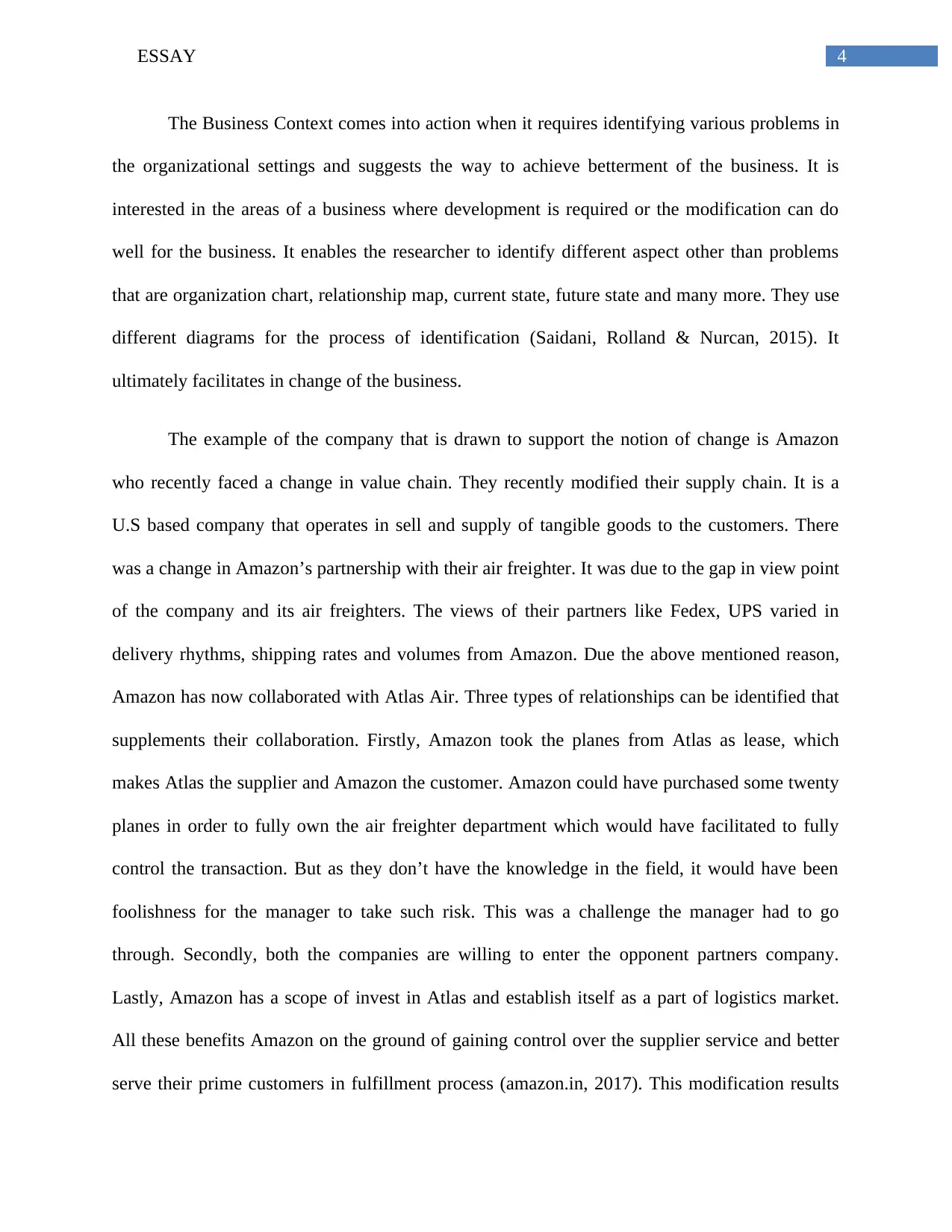
4ESSAY
The Business Context comes into action when it requires identifying various problems in
the organizational settings and suggests the way to achieve betterment of the business. It is
interested in the areas of a business where development is required or the modification can do
well for the business. It enables the researcher to identify different aspect other than problems
that are organization chart, relationship map, current state, future state and many more. They use
different diagrams for the process of identification (Saidani, Rolland & Nurcan, 2015). It
ultimately facilitates in change of the business.
The example of the company that is drawn to support the notion of change is Amazon
who recently faced a change in value chain. They recently modified their supply chain. It is a
U.S based company that operates in sell and supply of tangible goods to the customers. There
was a change in Amazon’s partnership with their air freighter. It was due to the gap in view point
of the company and its air freighters. The views of their partners like Fedex, UPS varied in
delivery rhythms, shipping rates and volumes from Amazon. Due the above mentioned reason,
Amazon has now collaborated with Atlas Air. Three types of relationships can be identified that
supplements their collaboration. Firstly, Amazon took the planes from Atlas as lease, which
makes Atlas the supplier and Amazon the customer. Amazon could have purchased some twenty
planes in order to fully own the air freighter department which would have facilitated to fully
control the transaction. But as they don’t have the knowledge in the field, it would have been
foolishness for the manager to take such risk. This was a challenge the manager had to go
through. Secondly, both the companies are willing to enter the opponent partners company.
Lastly, Amazon has a scope of invest in Atlas and establish itself as a part of logistics market.
All these benefits Amazon on the ground of gaining control over the supplier service and better
serve their prime customers in fulfillment process (amazon.in, 2017). This modification results
The Business Context comes into action when it requires identifying various problems in
the organizational settings and suggests the way to achieve betterment of the business. It is
interested in the areas of a business where development is required or the modification can do
well for the business. It enables the researcher to identify different aspect other than problems
that are organization chart, relationship map, current state, future state and many more. They use
different diagrams for the process of identification (Saidani, Rolland & Nurcan, 2015). It
ultimately facilitates in change of the business.
The example of the company that is drawn to support the notion of change is Amazon
who recently faced a change in value chain. They recently modified their supply chain. It is a
U.S based company that operates in sell and supply of tangible goods to the customers. There
was a change in Amazon’s partnership with their air freighter. It was due to the gap in view point
of the company and its air freighters. The views of their partners like Fedex, UPS varied in
delivery rhythms, shipping rates and volumes from Amazon. Due the above mentioned reason,
Amazon has now collaborated with Atlas Air. Three types of relationships can be identified that
supplements their collaboration. Firstly, Amazon took the planes from Atlas as lease, which
makes Atlas the supplier and Amazon the customer. Amazon could have purchased some twenty
planes in order to fully own the air freighter department which would have facilitated to fully
control the transaction. But as they don’t have the knowledge in the field, it would have been
foolishness for the manager to take such risk. This was a challenge the manager had to go
through. Secondly, both the companies are willing to enter the opponent partners company.
Lastly, Amazon has a scope of invest in Atlas and establish itself as a part of logistics market.
All these benefits Amazon on the ground of gaining control over the supplier service and better
serve their prime customers in fulfillment process (amazon.in, 2017). This modification results
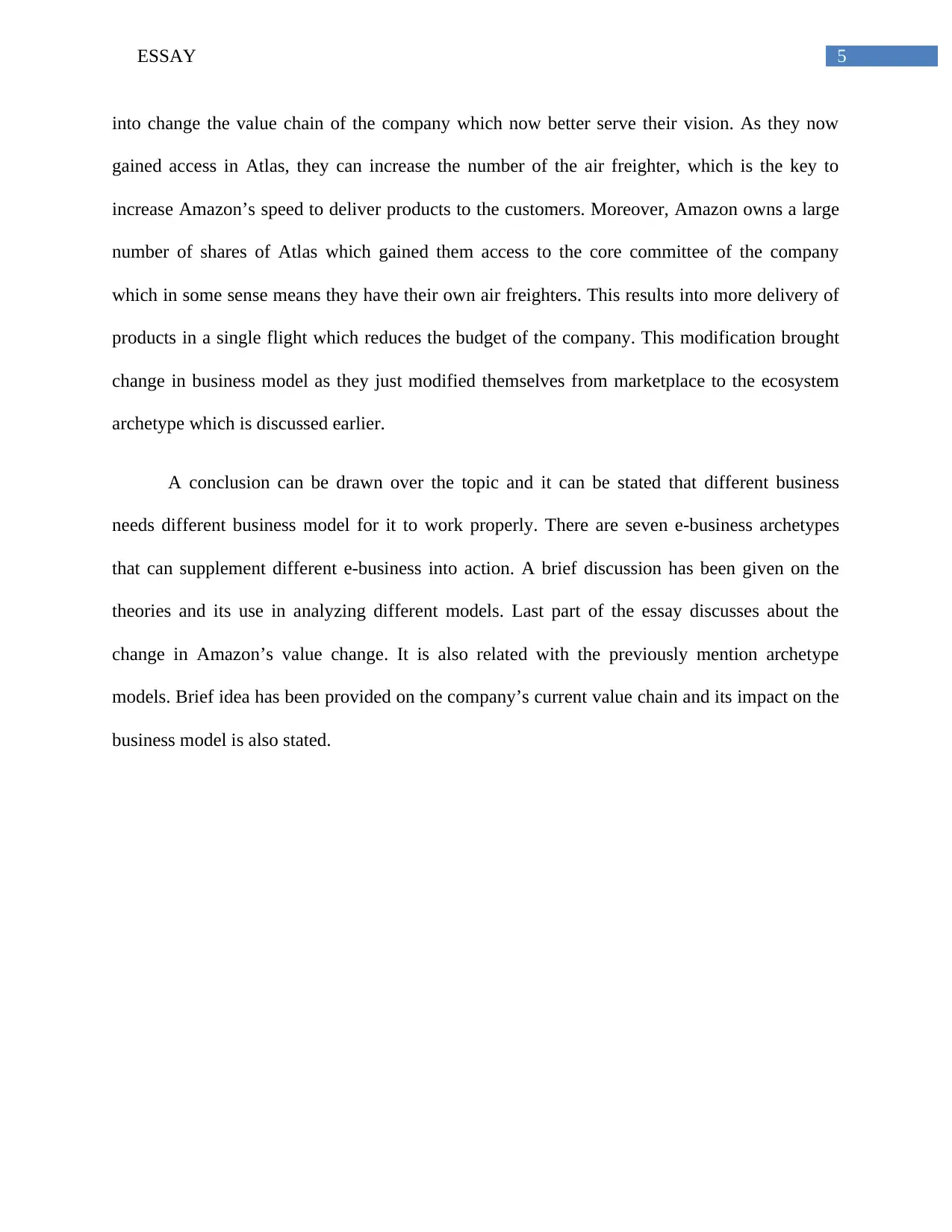
5ESSAY
into change the value chain of the company which now better serve their vision. As they now
gained access in Atlas, they can increase the number of the air freighter, which is the key to
increase Amazon’s speed to deliver products to the customers. Moreover, Amazon owns a large
number of shares of Atlas which gained them access to the core committee of the company
which in some sense means they have their own air freighters. This results into more delivery of
products in a single flight which reduces the budget of the company. This modification brought
change in business model as they just modified themselves from marketplace to the ecosystem
archetype which is discussed earlier.
A conclusion can be drawn over the topic and it can be stated that different business
needs different business model for it to work properly. There are seven e-business archetypes
that can supplement different e-business into action. A brief discussion has been given on the
theories and its use in analyzing different models. Last part of the essay discusses about the
change in Amazon’s value change. It is also related with the previously mention archetype
models. Brief idea has been provided on the company’s current value chain and its impact on the
business model is also stated.
into change the value chain of the company which now better serve their vision. As they now
gained access in Atlas, they can increase the number of the air freighter, which is the key to
increase Amazon’s speed to deliver products to the customers. Moreover, Amazon owns a large
number of shares of Atlas which gained them access to the core committee of the company
which in some sense means they have their own air freighters. This results into more delivery of
products in a single flight which reduces the budget of the company. This modification brought
change in business model as they just modified themselves from marketplace to the ecosystem
archetype which is discussed earlier.
A conclusion can be drawn over the topic and it can be stated that different business
needs different business model for it to work properly. There are seven e-business archetypes
that can supplement different e-business into action. A brief discussion has been given on the
theories and its use in analyzing different models. Last part of the essay discusses about the
change in Amazon’s value change. It is also related with the previously mention archetype
models. Brief idea has been provided on the company’s current value chain and its impact on the
business model is also stated.
⊘ This is a preview!⊘
Do you want full access?
Subscribe today to unlock all pages.

Trusted by 1+ million students worldwide
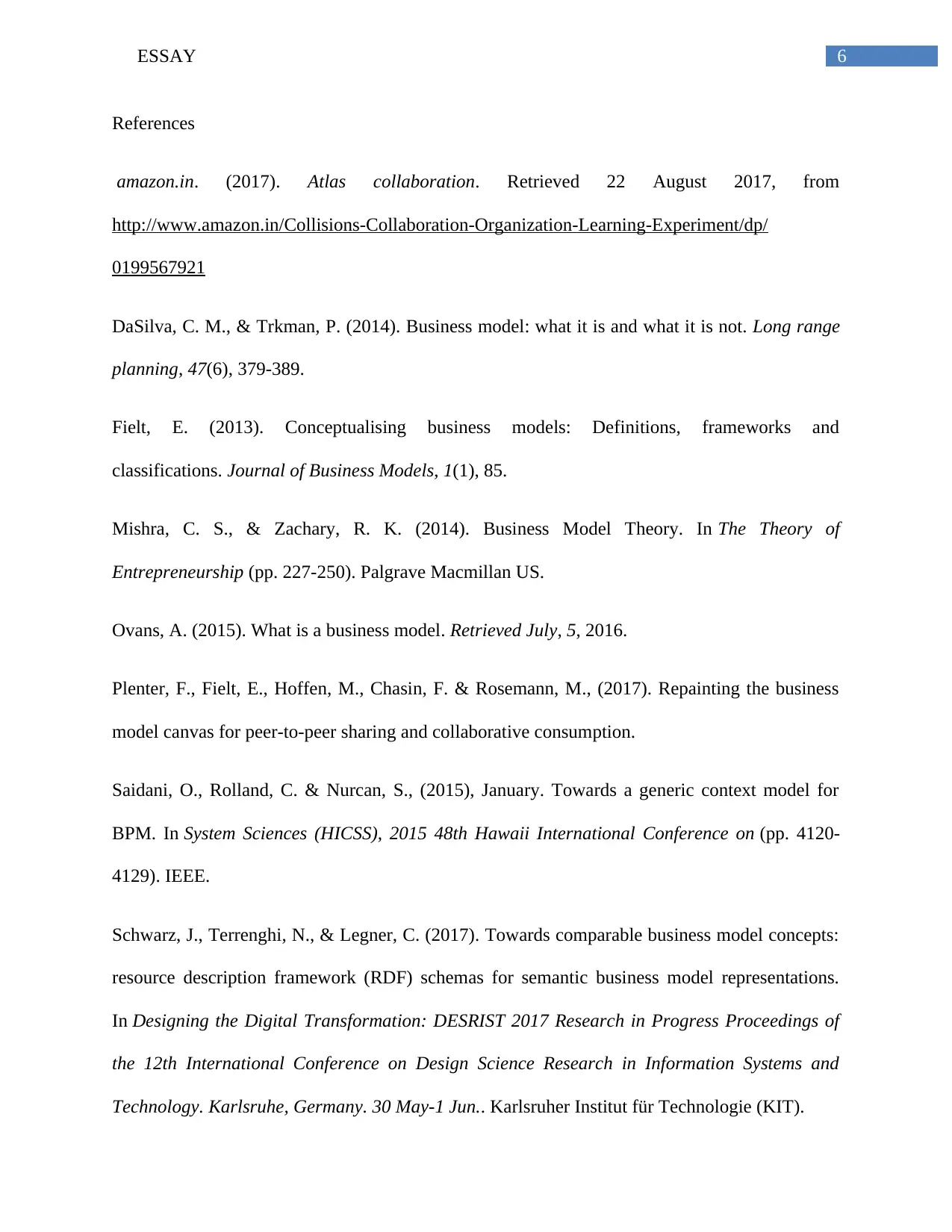
6ESSAY
References
amazon.in. (2017). Atlas collaboration. Retrieved 22 August 2017, from
http://www.amazon.in/Collisions-Collaboration-Organization-Learning-Experiment/dp/
0199567921
DaSilva, C. M., & Trkman, P. (2014). Business model: what it is and what it is not. Long range
planning, 47(6), 379-389.
Fielt, E. (2013). Conceptualising business models: Definitions, frameworks and
classifications. Journal of Business Models, 1(1), 85.
Mishra, C. S., & Zachary, R. K. (2014). Business Model Theory. In The Theory of
Entrepreneurship (pp. 227-250). Palgrave Macmillan US.
Ovans, A. (2015). What is a business model. Retrieved July, 5, 2016.
Plenter, F., Fielt, E., Hoffen, M., Chasin, F. & Rosemann, M., (2017). Repainting the business
model canvas for peer-to-peer sharing and collaborative consumption.
Saidani, O., Rolland, C. & Nurcan, S., (2015), January. Towards a generic context model for
BPM. In System Sciences (HICSS), 2015 48th Hawaii International Conference on (pp. 4120-
4129). IEEE.
Schwarz, J., Terrenghi, N., & Legner, C. (2017). Towards comparable business model concepts:
resource description framework (RDF) schemas for semantic business model representations.
In Designing the Digital Transformation: DESRIST 2017 Research in Progress Proceedings of
the 12th International Conference on Design Science Research in Information Systems and
Technology. Karlsruhe, Germany. 30 May-1 Jun.. Karlsruher Institut für Technologie (KIT).
References
amazon.in. (2017). Atlas collaboration. Retrieved 22 August 2017, from
http://www.amazon.in/Collisions-Collaboration-Organization-Learning-Experiment/dp/
0199567921
DaSilva, C. M., & Trkman, P. (2014). Business model: what it is and what it is not. Long range
planning, 47(6), 379-389.
Fielt, E. (2013). Conceptualising business models: Definitions, frameworks and
classifications. Journal of Business Models, 1(1), 85.
Mishra, C. S., & Zachary, R. K. (2014). Business Model Theory. In The Theory of
Entrepreneurship (pp. 227-250). Palgrave Macmillan US.
Ovans, A. (2015). What is a business model. Retrieved July, 5, 2016.
Plenter, F., Fielt, E., Hoffen, M., Chasin, F. & Rosemann, M., (2017). Repainting the business
model canvas for peer-to-peer sharing and collaborative consumption.
Saidani, O., Rolland, C. & Nurcan, S., (2015), January. Towards a generic context model for
BPM. In System Sciences (HICSS), 2015 48th Hawaii International Conference on (pp. 4120-
4129). IEEE.
Schwarz, J., Terrenghi, N., & Legner, C. (2017). Towards comparable business model concepts:
resource description framework (RDF) schemas for semantic business model representations.
In Designing the Digital Transformation: DESRIST 2017 Research in Progress Proceedings of
the 12th International Conference on Design Science Research in Information Systems and
Technology. Karlsruhe, Germany. 30 May-1 Jun.. Karlsruher Institut für Technologie (KIT).
Paraphrase This Document
Need a fresh take? Get an instant paraphrase of this document with our AI Paraphraser
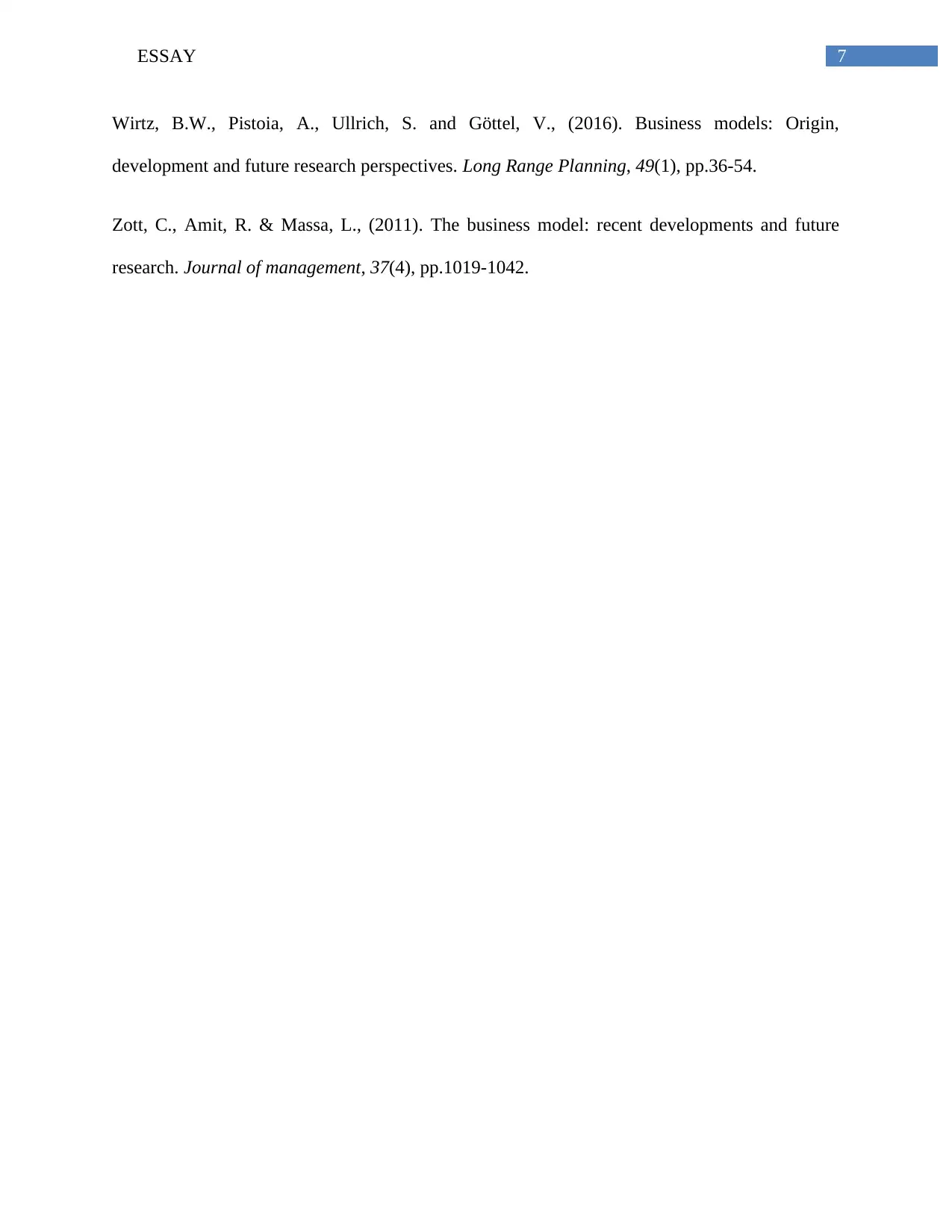
7ESSAY
Wirtz, B.W., Pistoia, A., Ullrich, S. and Göttel, V., (2016). Business models: Origin,
development and future research perspectives. Long Range Planning, 49(1), pp.36-54.
Zott, C., Amit, R. & Massa, L., (2011). The business model: recent developments and future
research. Journal of management, 37(4), pp.1019-1042.
Wirtz, B.W., Pistoia, A., Ullrich, S. and Göttel, V., (2016). Business models: Origin,
development and future research perspectives. Long Range Planning, 49(1), pp.36-54.
Zott, C., Amit, R. & Massa, L., (2011). The business model: recent developments and future
research. Journal of management, 37(4), pp.1019-1042.
1 out of 8
Related Documents
Your All-in-One AI-Powered Toolkit for Academic Success.
+13062052269
info@desklib.com
Available 24*7 on WhatsApp / Email
![[object Object]](/_next/static/media/star-bottom.7253800d.svg)
Unlock your academic potential
Copyright © 2020–2025 A2Z Services. All Rights Reserved. Developed and managed by ZUCOL.





